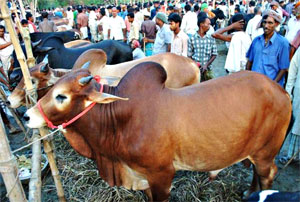Indian restriction on sending cattle to Bangladesh on religious ground has proved a blessing in disguise. It has become a boon for Bangladesh as many youths are setting up farms to boost meat and milk production, ushering in hopes for reducing deficits in dairy and beef production to surplus at the end.
Compared to the past, Bangladesh is in a better position today to ensure enough cattle supply ahead of the Eid-ul-Azha, say officials of the Department of Livestock Services (DLS).
In fact a revolution has been taking place in this sector for the last one year.
Many educated unemployed youths started farming for dairy products and fattening cattle in order to become self-reliant.
As per DLS estimates, nearly 88 lakh cattle are slaughtered annually in Bangladesh, of which almost 50 percent or even more are slaughtered during the Eid-ul-Azha, the second biggest religious festival of the Muslims.
In the past, over 20 lakh cattle were informally traded from India through the borders due to lax monitoring by border security guards on both sides. It accounted for nearly $1 billion annual business.
During that time, local farmers used to be less enthusiastic about cattle farming, fearing losses due to the huge arrival of Indian cattle. Prices of sacrificial cattle remain low as the supply was on high sides from across the border.
The flow, however, has become a trickle in the last two fiscal years because of a crackdown by the Indian authorities. More than 11.5 lakh cattle entered Bangladesh from neighbouring countries, mainly from India, in fiscal year 2015-16, down from 14 lakh the previous year, according to National Board of Revenue (NRB) data. The number was around 21 lakh in 2013-14.
Following the fall in the supply of Indian cattle, beef prices rose sharply in the domestic market in Bangladesh, encouraging local farmers to rear more cattle and youths joined it as commercial activities.
It seems locally reared and fattened cattle would be enough to meet Bangladesh’s demand for meat during this Eid. said a local breeder who has 150 cows in Narayanganj district.
Apart from areas adjacent to Dhaka, farmers in various other districts, particularly in Pabna, Sirajganj, Nilphamari and Patuakhali, have reared and fattened bulls for profit.
Low-cost loans, with a five percent interest rate, provided to farmers under Bangladesh Bank’s refinance scheme also encouraged cattle farming.
Reduced dependence on Indian cattle
Sources in trade circle said dependence on Indian cattle would come down to 10 percent of the total demand of over 40 percent in recent past. Bangladesh Meat Merchants’ Association (BMMA) sources said it is going down for the last two years, adding that supply of locally-reared cattle was around 40 lakh or some 70 percent of total 55 lakh bulls and buffaloes slaughtered during the last Eid.
The supply of locally-farmed cattle would rise further this year, the source said expecting that similar number of cattle would be slaughtered this year.“Our dependence on Indian cattle will be only one-tenth of the demand the next year,” he said.
Department of Livestock Services said the supply of locally-reared cattle may rise to 44 lakh during this Eid. It was 41 lakh during the Eid last year.
The number of cattle being fattened has increased 10 percent from last year to 33 lakh.
The supply of 44 lakh home-reared cattle would be around 80 percent of the total demand which DLS and association of tanners, meat, hide and skin merchants estimate at 50-55 lakh.
Source: Weekly Holiday

